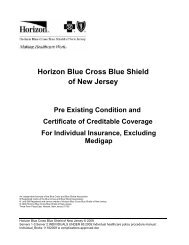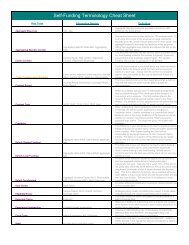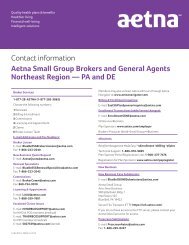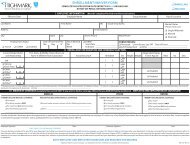Self-Funding Terminology Cheat Sheet
Self-Funding Terminology Cheat Sheet
Self-Funding Terminology Cheat Sheet
Create successful ePaper yourself
Turn your PDF publications into a flip-book with our unique Google optimized e-Paper software.
Immature Rate<br />
Individual Stop Loss<br />
Lag Report<br />
First Year Rate, 10-Month Rate<br />
ISL, SSL, Specific Stop Loss Level, Pooling<br />
Point, Large Claim Deductible<br />
IBNR report<br />
A reduced pricing structure reserved for the first 12 months of<br />
a plan. Such a rate is possible due to reduced claims liability in<br />
months one and two of a first year plan because of the claim<br />
lag. Fully insured carriers may price at an immature level, but<br />
most often this is seen in <strong>Self</strong>-Funded plans offered through<br />
third party administrators. This arrangement typically results in<br />
a maturing factor being applied at renewal.<br />
Individual stop-loss insurance provides reimbursement in the<br />
event an individual plan participant has claims that exceed the<br />
ISL Level during a contract period. In some states mandate<br />
minimum stop loss levels.<br />
Usually requested for a client's accounting/audit purposes, this<br />
report helps them determine an estimated terminal or runout<br />
liability, based on lag times seen on the plan during the<br />
preceding 12 month period.<br />
Lagged Membership -<br />
Refers to a lag applied to membership. Graded <strong>Funding</strong><br />
applies a 2-month lag to membership for determining monthly<br />
claims liability. When underwriting claims experience, it is also<br />
typical to see a 1 or 2 month lag applied to monthly<br />
membership. In both scenarios, the lag is applied to account<br />
for the relationship between enrollment data and paid claims.<br />
Laser -<br />
This is an additional form of risk to the employer. For large<br />
claimants which may be ongoing, the stop loss carrier alters<br />
the ISL coverage for certain claimant(s). For instance, if the<br />
client's ISL level is $25,000, an individual with a serious<br />
ongoing claim may have their own ISL of $150,000. The<br />
difference between the $25,000 and $150,000 may or may not<br />
accumulate to the employer's aggregate claim liability, which<br />
means they will likely reach or exceed claim liability. Some<br />
carriers do not mandate lasers; however, many will consider<br />
this upon employer or broker request.<br />
Mature Rate - Reflects a full, 12-month claims liability.<br />
Minimum Attachment<br />
Monthly Claim Liability<br />
Non-Pooled Claims<br />
Paid Contract -<br />
Plan Year<br />
Pooled Claims<br />
Premium Statement -<br />
Reinsurance Carrier<br />
MA<br />
Claim liability, Maximum claim exposure,<br />
Aggregate Liability, MAF = Monthly Attachment<br />
Factor (Graded <strong>Funding</strong>), MCF = Monthly Claim<br />
<strong>Funding</strong> (Level <strong>Funding</strong>)<br />
Aggregate Claims, claims under the pooling level<br />
Benefit Period<br />
ISL claims, SSL claims, Specific Claims, Large<br />
Claims, Shock Claims<br />
Reinsurer<br />
Run-In Bridge Protection, 15/12<br />
A provision which sets a minimum claim attachment liability in<br />
the event the client's enrollment shrinks. This allows insurer<br />
and the client to control costs and risk should the enrollment<br />
shrink. Calculated based upon a percentage of enrollment<br />
(can be 90%, 95% or 100%) at the time of renewal. This is<br />
typically not included in Level <strong>Funding</strong> products, but is typically<br />
included in the Graded <strong>Funding</strong> product.<br />
The amount, expressed in dollars per employee (and/or<br />
dependent) per month used to define the claim liability for each<br />
month. See Attachment Factor and Claims <strong>Funding</strong>.<br />
Some <strong>Self</strong>-Funded clients buy insurance protection against<br />
large individual claims. Paid claims up to the ISL threshold are<br />
client liability, and accumulate to the client's aggregate stop<br />
loss limits. Anything over the ISL threshold are Pooled claims.<br />
The term non-pooled literally comes from the fact that these<br />
claims are not "pooled" with other groups claims (see Pooled<br />
Claims definition).<br />
Refers to a self-funded contract which is providing stop loss<br />
protection for all claims Incurred under the life of the policy that<br />
are paid during the 12 month contract period. Some contracts<br />
renew to a paid contract at their first renewal.<br />
The 12-month period in which deductible and coinsurance<br />
accumulates toward a plan participant's out-of-pocket<br />
maximums.<br />
Some <strong>Self</strong>-Funded clients buy insurance protection against<br />
large individual claims. Paid claims exceeding the ISL<br />
threshold are not client liability, and go to the "pool", thereby<br />
becoming pooled claims. Some insurers, at renewal pooled<br />
claims are pulled out of the experience analysis to provide<br />
smaller groups more stability in their renewal increases.<br />
This provides a listing of all employees with coverage levels<br />
and premiums being billed. Premiums reflect Fixed Costs<br />
(administrative fees including commissions and stop loss<br />
premium) only.<br />
This is the stop loss carrier providing ISL and/or ASL<br />
protection to an employer. In a TPA arrangement, this is<br />
usually a third party/entity, and therefore is not integrated.<br />
Claims incurred prior to the first contract year and received<br />
after the new effective date. These claims can be paid under a<br />
"current year" contract that includes a run-in provision. Some<br />
insurers can offer run-in protection on ISL, and must be<br />
coordinated/priced for with underwriting. Pricing differs for<br />
bridge protection versus a 15/12 contract (15/12 is more<br />
protective and therefore has a higher premium, typically).


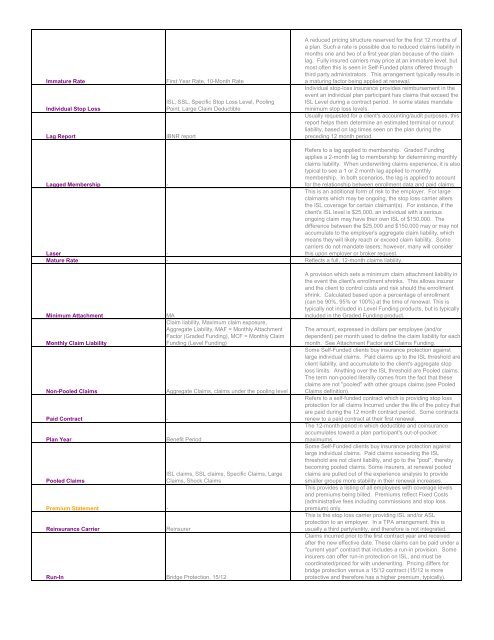

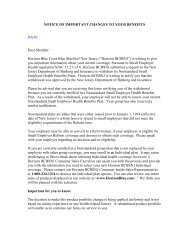
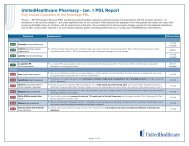
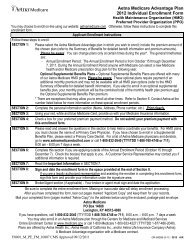
![[Letter Date] [First Name] [Last Name] [Street Address] [City, State ...](https://img.yumpu.com/49910635/1/190x245/letter-date-first-name-last-name-street-address-city-state-.jpg?quality=85)

